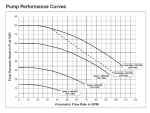Starting to build a new pool (actually, halfway done) and having trouble reconciling piping recommendations based on GPM.
Based on what I have read, 2" piping only supports around 80GPM (or 63GPM on suction and 84GPM on return side). There are other small variations across websites but its universally somewhere around 80GPM but more conservative would be to aim around 63GPM (based on suction side).
Numbers for 1.5" are around 35GPM suction and 50GPM return.
QUESTION:
Pentair 1.5HP VS pump can go up to 100GPM (see the picture from brochure below), yet, it has unionized fittings of 1.5" and 2" based on the installation manual. I called Pentair and was told the actual opening is 1.5" - so, it should support up to 50GPM from everything I have read. They couldn't provide any reasonable explanation ("that's how it is").
Can anybody help explain what I am missing? Why pump rated above 80GMP has fittings less than 2.5"?
Thank you
P.S. I have cartridge filter that is rated at 150GPM and it has 2.5" fittings.

Based on what I have read, 2" piping only supports around 80GPM (or 63GPM on suction and 84GPM on return side). There are other small variations across websites but its universally somewhere around 80GPM but more conservative would be to aim around 63GPM (based on suction side).
Numbers for 1.5" are around 35GPM suction and 50GPM return.
QUESTION:
Pentair 1.5HP VS pump can go up to 100GPM (see the picture from brochure below), yet, it has unionized fittings of 1.5" and 2" based on the installation manual. I called Pentair and was told the actual opening is 1.5" - so, it should support up to 50GPM from everything I have read. They couldn't provide any reasonable explanation ("that's how it is").
Can anybody help explain what I am missing? Why pump rated above 80GMP has fittings less than 2.5"?
Thank you
P.S. I have cartridge filter that is rated at 150GPM and it has 2.5" fittings.

Last edited:

